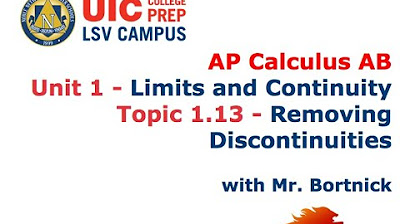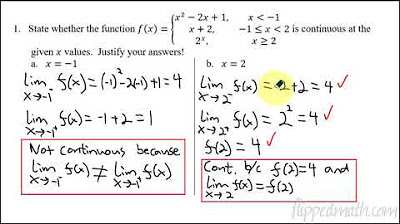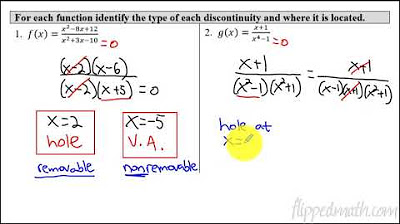Calculus AB/BC – 1.13 Removing Discontinuities
TLDRIn this calculus lesson, Mr. Bean explains the concept of removable discontinuities, which are essentially 'holes' in a function's graph. He demonstrates how to identify the x and y coordinates of these discontinuities and then fill them in to make the function continuous. The lesson includes examples of how to find the y-value of a hole by evaluating the limit as x approaches the point of discontinuity. This straightforward approach is illustrated with step-by-step examples, making it accessible for students preparing for the AP exam.
Takeaways
- 📚 The lesson is about removing a removable discontinuity in calculus, which is essentially filling in a 'hole' in the graph of a function.
- 🕳️ A removable discontinuity is defined as a point where the limit exists but the function's value at that point is different from the limit.
- 🔍 To identify a removable discontinuity, one must find the x-coordinate of the hole, which is where the function is undefined.
- 📝 The y-coordinate of the hole is found by evaluating the limit of the function as x approaches the value where the hole is located.
- 👉 For example, if a function has a hole at x = 1, the y-value is determined by finding the limit of the function as x approaches 1.
- 📉 In the script, an example is given where the function is undefined at x = -4, and the y-value to fill the hole is found by taking the limit as x approaches -4.
- 🔢 The process involves simplifying the function and factoring to identify where the discontinuity occurs, such as in the example where (x - 1)(x + 1) / (x - 1) leads to a hole at x = 1.
- 📈 The concept of continuity is also discussed, emphasizing that a continuous function has no gaps, jumps, or holes.
- 🔄 The script provides step-by-step instructions on how to find the y-value for a hole by considering the limit of the function.
- 📚 The lesson is designed to be straightforward and short, aiming to help students understand the concept of removable discontinuities.
- 🎓 The examples given are relevant to what might be asked on an AP exam, indicating the practical application of the concept in a testing scenario.
Q & A
What is the main topic of the lesson presented by Mr. Bean?
-The main topic of the lesson is how to remove a removable discontinuity in calculus.
What is a removable discontinuity according to the script?
-A removable discontinuity is a hole in the graph of a function where the limit exists from both sides but the function's value at that point is different from the limit.
How does the script describe the process of removing a discontinuity?
-The process involves identifying the x and y coordinates of the hole (discontinuity) and then filling it in with the value that makes the function continuous at that point.
What mathematical concept is used to find the y-coordinate of the hole?
-The concept of finding the limit of the function as x approaches the value where the hole is located is used to determine the y-coordinate of the hole.
In the script, what is the first step to identify the x-coordinate of the hole?
-The first step is to factor the function and identify where the denominator equals zero, which indicates the x-coordinate of the hole.
What is the example function given in the script to demonstrate the removal of a discontinuity?
-The example function is (x - 1)(x + 1) / (x - 1), which simplifies to x + 1 after canceling out the common factor.
What is the hole's x-coordinate in the first example provided in the script?
-The hole's x-coordinate is 1, as determined by setting the denominator (x - 1) equal to zero.
How is the y-coordinate of the hole found in the first example?
-The y-coordinate is found by taking the limit of the simplified function (x + 1) as x approaches 1, which results in a y-value of 2.
What does the script suggest for the function to be continuous at x = -4?
-The script suggests that to make the function continuous at x = -4, the value of the function at that point should be the limit of the function as x approaches -4, which is -2.
In the last example, how is the value of 'a' determined to make the function continuous at x = 6?
-The value of 'a' is determined by setting the two pieces of the piecewise function equal to each other at x = 6, which results in a = 9.
What does the script imply about the relationship between the two pieces of a piecewise function to ensure continuity?
-The script implies that for a piecewise function to be continuous at a certain point, the two pieces of the function must be equal at that point.
Outlines
📚 Introduction to Removing Removable Discontinuities
Mr. Bean introduces the concept of removable discontinuities in calculus, explaining it as a 'hole' in the graph of a function. He clarifies that a removable discontinuity occurs when the limit exists from both sides but is not equal to the function's value at that point. The lesson's goal is to demonstrate how to remove such discontinuities by identifying the point of discontinuity and filling in the hole with the correct value, thus making the function continuous. The first example involves a function with a hole at x=1, where the function is simplified, and the limit is used to find the y-value of the hole, which is 2, indicating the point (1,2) where the discontinuity should be removed.
🔍 Identifying and Filling Holes for Continuity
The second paragraph continues the discussion on removing discontinuities by providing a method to identify the x-value of the hole through factoring and solving for when the denominator equals zero. It then shows how to find the y-value of the hole by evaluating the limit as x approaches the value that causes the discontinuity. The example given involves a function that is continuous everywhere except at x=-4, where the function's value needs to be determined to fill in the hole and ensure continuity. By factoring and finding the limit, the y-value of the hole is found to be -2, which is the value required to make the function continuous at x=-4. The paragraph concludes with another example of a piecewise function, where the task is to determine the value of 'a' that makes the function continuous at x=6, which is found to be 9 by ensuring the two pieces of the function are equal at that point.
Mindmap
Keywords
💡Calculus
💡Removable Discontinuity
💡Limit
💡Continuous Function
💡Factoring
💡Hole
💡X and Y Coordinates
💡Piecewise Function
💡Derivative
💡Integral
Highlights
Introduction to the concept of removing a discontinuity in calculus.
Definition of a removable discontinuity as a 'hole' in the graph of a function.
Explanation of the mathematical representation of a removable discontinuity using limit notation.
The importance of identifying the x and y coordinates of the hole to remove the discontinuity.
A step-by-step method to find the x value of the hole by factoring the function.
How to determine the y value of the hole by evaluating the limit as x approaches the discontinuity point.
Example of removing a discontinuity by filling in the hole with the correct y value.
Discussion on the concept of a function being continuous and its implications on the graph.
Explanation of how to handle a function defined piecewise with a discontinuity.
Technique to ensure a function is continuous by making the two pieces of a piecewise function equal at the point of discontinuity.
Application of the method to a specific function to find the y value that makes the function continuous.
The significance of understanding the limit to determine the y value of a hole in a function.
Illustration of how to rewrite a function in factored form to identify the discontinuity.
The process of canceling terms in a function to find the value that creates a hole.
How to plug in the x value of the hole to find the corresponding y value.
The final step of filling in the hole with the correct y value to make the function continuous.
The practical application of these concepts in preparing for an AP exam.
Encouragement for students to master these techniques for success in calculus.
Transcripts
Browse More Related Video

AP Calculus AB - 1.13 Removing Discontinuities

Three Types of Discontinuities in Functions

Calculus AB/BC – 1.11 Defining Continuity at a Point

Calculus AB/BC – 1.10 Exploring Types of Discontinuities

Continuity

Continuity Basic Introduction, Point, Infinite, & Jump Discontinuity, Removable & Nonremovable
5.0 / 5 (0 votes)
Thanks for rating: